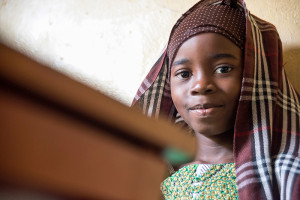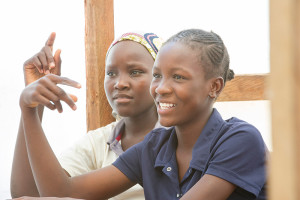Education for Nigeria’s displaced children featured on VOA
By Jillian SlutzkerOctober 29, 2015
A six-year insurgency in northern Nigeria has displaced 2.2 million—including more than 1 million terrified school-aged children. Ripped from their communities, schools and often families, the educational and psychosocial needs of these children are immense.
On the one-year anniversary of the Nigeria Education Crisis Response Program—aimed at expanding access to quality and protective non-formal education for these out-of-school children and youth—their plight and the transformative response was the focus of Voice of America’s HashtagVOA broadcast.
The Education Crisis Response Program launched Oct. 27, 2014, and is led by Semere Solomon, Senior Associate and Africa expert at Creative Associates International, which implements the initiative.
“It’s been pretty miraculous, the transformation that we’ve been able to see in a short amount of time for those children and youth in our programs,” said HashtagVOA guest, Eileen St. George, Director of Education in Conflict at Creative.
In its first year, the three-year program—funded by the U.S. Agency for International Development—has reached more than 20,000 displaced, out-of-school children and youth ages 6 to 17 with critical psychosocial services, in-class meals and learning opportunities in non-formal centers.
When media tend to dwell on the violence and conflict wrought by insurgents, shining a spotlight on the positive efforts of Nigerian communities and international donors is critical, HashtagVOA co-host Cynthia Areh told viewers.
“People need to hear about the optimistic side, in the midst of the chaos because there is progress,” said Areh, who is also a Lagos-based TV journalist and anchor.
A partnership from the ground up

Despite limited resources in areas receiving those displaced by insurgency, said St. George, community leaders and members are welcoming displaced children and families, and helping to secure the safe spaces and support they need to overcome trauma and regain a sense of stability.
“We know there are limited resources in those areas, but those communities are embracing them, sharing what they have and bringing these youth and children into their homes and providing education for them through our support,” she said.
The Education Crisis Response Program partners with and supports local and state governments and community organizations—including more than 290 non-formal learning centers such as schools, religious establishments and meeting houses—to bring these much needed services to vulnerable children.
“We say ‘support’ because we can’t go in and do it by ourselves. We can come in with great ideas and help mobilize a community to realize their own need and how it needs to be responded to, and provide them some of the technical capacity to build the knowledge and the skill sets to implement the program,” said St. George.
The program’s on-the-ground team is entirely staffed by Nigerians, a key to growing local capacity and ensuring long-term success for the program, said St. George.
Working in conflict, supporting the most vulnerable

In conflict and crisis-affected communities, like those in northern Nigeria, education plays a key role in restoring a sense of normalcy in the community and helping children to heal from trauma.
“When you help stabilize the children and the youth, you’re stabilizing the entire family and the community around them,” said St. George.
Creative has a long history of working with some of the most at-risk children and youth in these hotspots, where physical safety and psychosocial needs are top priorities.
A key focus of the Education Crisis Response program has been helping to secure safe and protected spaces for these children and families.
The program not only helps to establish non-formal learning centers, but also partners with communities to create a welcome and safe environment. An estimated 90 percent of those displaced live with friends and relatives.
In its three years, the Education Crisis Reponses Program aims to reach more than 59,000 displaced school-aged children and youth with critical learning and psychosocial support to rebuild their lives and move toward a promising future; but as St. George mentions, the need is still great.
“We’re touching just a drop in the bucket. There are so many more children and youth out there.”

